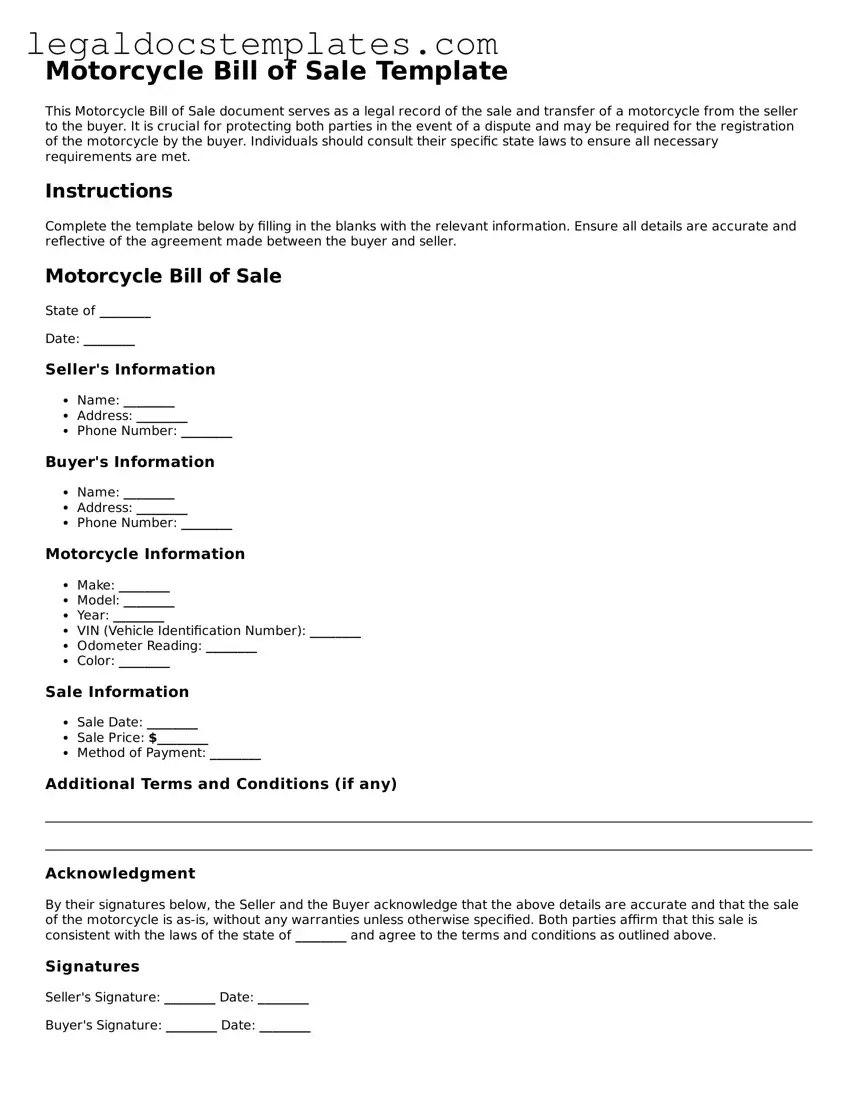A Vehicle Bill of Sale is remarkably similar to a Motorcycle Bill of Sale. Both forms are legal documents that record the transaction between a seller and a buyer, specifying the transfer of ownership of a vehicle. They typically include details such as the make, model, year, VIN (Vehicle Identification Number), the agreed price, and the signatures of both parties involved. While one pertains to motorcycles, the other can be used for cars, trucks, or any other types of vehicles.
An Aircraft Bill of Sale also shares a close resemblance. This document functions in the same way by documenting the sale and transfer of ownership of an aircraft. It includes pertinent details such as the aircraft's make, model, serial number, and the terms of the sale. Despite the difference in the type of asset being sold, the purpose and structure of the document remain consistent with that of a Motorcycle Bill of Sale.
A Boat Bill of Sale is yet another document with striking similarities. It's used to transfer the ownership of a boat from one party to another. Like the Motorcycle Bill of Sale, it includes important information like the boat's make, model, length, year, hull identification number (HIN), the sale price, and it requires the signatures of both the buyer and seller. The main difference lies in the type of property being bought and sold.
Similarly, the Firearms Bill of Sale is used to document the sale and transfer of ownership of a firearm. It typically includes details such as the make, model, caliber, and serial number of the firearm, along with the buyer's and seller's information, the sale price, and signatures. This parallels the Motorcycle Bill of Sale in its function to legally document the transfer of an item from seller to buyer, though it specifically concerns firearms.
A Business Bill of Sale serves the purpose of recording the sale of a business entity from one party to another. It details the assets being transferred, including but not limited to equipment, inventory, and client lists, along with the sale price and conditions. Much like a Motorcycle Bill of Sale, it serves to legally document the sale and ensure a clear transition of ownership, albeit on a potentially larger scale.
The Equipment Bill of Sale is used for the purchase and sale of equipment and machinery. It includes the description of the equipment, identification number, the sale amount, and the parties' signatures. This document is akin to the Motorcycle Bill of Sale in that it facilitates the legal transfer of physical assets, ensuring that both parties acknowledge the transfer and terms of sale.
A General Bill of Sale is a broad document that can be used for various personal property items besides vehicles or boats, such as furniture, electronics, or art. It generally includes a description of the items being sold, the sale price, and the signatures of both parties. This document is similar to a Motorcycle Bill of Sale in terms of its function to legally document the sale of personal property, offering a versatile template for various items.
A Pet Bill of Sale is used specifically for the sale of animals, typically detailing the breed, sex, color, and health information of the pet, alongside the sale terms and signatures. It is akin to a Motorcycle Bill of Sale in its purpose to document the sale and transfer of ownership of a living asset, ensuring all agreements regarding the sale are formally recorded.
A Real Estate Bill of Sale is somewhat similar but used for the transaction of property rights or real estate, including details about the land or property, the sale amount, and the involved parties' signatures. While it deals with real estate rather than movable property, the core intent to document ownership transfer securely and legally mirrors the purpose of a Motorcycle Bill of Sale.
Lastly, an Intellectual Property (IP) Bill of Sale documents the sale and transfer of ownership of intellectual property, such as patents, copyrights, trademarks, or trade secrets. This includes details about the IP being sold, the parties involved, the sale price, and conditions. Though it concerns non-tangible assets, the fundamental goal to legally record and safeguard the transfer of ownership is parallel to that of a Motorcycle Bill of Sale.
